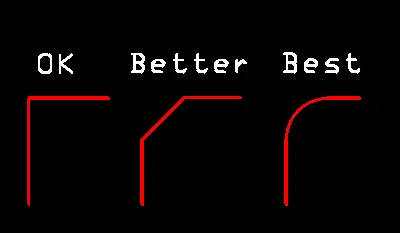
How to set-up the best track (routing) corners in PCB layout? Which is a better option, 45° corner or rounded corner? Can be layout as 90° corner?

The circuit corner of high-speed track is always a hot topic when we talk PCB design and layout. A lot of PCB designers have the opinions of that high speed signals should be tracked by the 45° angles instead of right angles, and arguably the arc will be greater than 45°, and even the corners track is much better.

So, whether the PCB layout can be routed at 90° angle at the circuit track corner?
High-frequency and high-speed signal transmission trace in a printed circuit board should be avoided being routed at a 90° corner, which is strongly required in various of PCB design guidelines. Because high-frequency and high-speed signal transmission track needed to keep the consistent characteristic impedance performance. But, the transmission track width would be changed if using 90° angel at corner layout, due to the track width at 90° corner is 1.414 times than normal track width. The width changed track will generate the reflected signals. At the same time, the extra parasitic capacitance at the corners will also lead to time-consuming signal transmission, and the delay response.

Of course, when the transmission signal travels along a uniform interconnection, the transmitted signal will be free of reflections and distortions. If there is any 90° corner existing on uniform interconnection, it will result in a change in the width of the PCB transmission track at the corner. According to the calculation of relevant electromagnetic theory, this will definitely bring about the reflection impacting of the signals.
Theoretically yes, but a theory is a theory after all.

For high-speed digital signals track layout, the 90° corner routing will have some extra impact to the high-speed signal track’s transmission. Currently, most of high density and high speed PCBs have the typical 4-5mil width trace 4-5mil with the 10fF capacitance at a 90° corner. It is statisticed that there is around 0.25 seconds cumulative transmission delay caused by this capacitor, so a 90° corner design existing in a circuit track with 5mil width will not have much impact on today’s high-speed digital signals transmission(100 psec rise time).
For high-frequency signal transmission track, in order to avoid signal damaging caused by skin effect, usually it is preferable to use wider signal transmission track such as 50Ω impedance and 100mil track width. The track width at the 90°corner is about 141mil, and the signal transmission delay due to parasitic capacitance is about 25ps. At this point, the 90°corner track will have a very serious affection.
At the same time, microwave transmission track is always expected to less signal loss. Impedance discontinuities at the 90°corner and external parasitic capacitance will cause phase and amplitude deviation of high frequency signals, mismatches between input and output, and potential parasitic coupling, resulting in degraded circuit performance and affecting PCB circuitry transmission characteristics of the signal.
Regarding 90° signal trace routing, our proposal is to avoid 90° corner routing in PCB layout as much as possible. The influence of a single 90° on the signal quality of high-speed digital transmission track, the deviation relative to the height of the track and the reference plane, the deviation of the uniformity of the line width and line spacing during the etching process of the track itself, and the influence of the dielectric constant of the sheet on the frequency signal variation, Far more problematic than a 90° angle, even though parasitic effects.
However, today’s high-speed digital circuit transmission track always has to be wound around the same length. When more than ten or twenty corners overlap, the transmission signal rising delay caused by the cumulative impacting of these 90° corners becomes non-negligible. The high-speed signal always travels along the impedance track, the 90° corner length is equal, and the final actual signal transmission path will be slightly shorter than the original path.
At the same time, PCB routing wires at a 90° corner does not meet people’s aesthetics in terms of engineering aesthetics. Therefore, for the current PCB layout, regardless of whether you are using high frequency/high speed signal lines, you should try to avoid 90° corner track routing unless you have special requirements.





